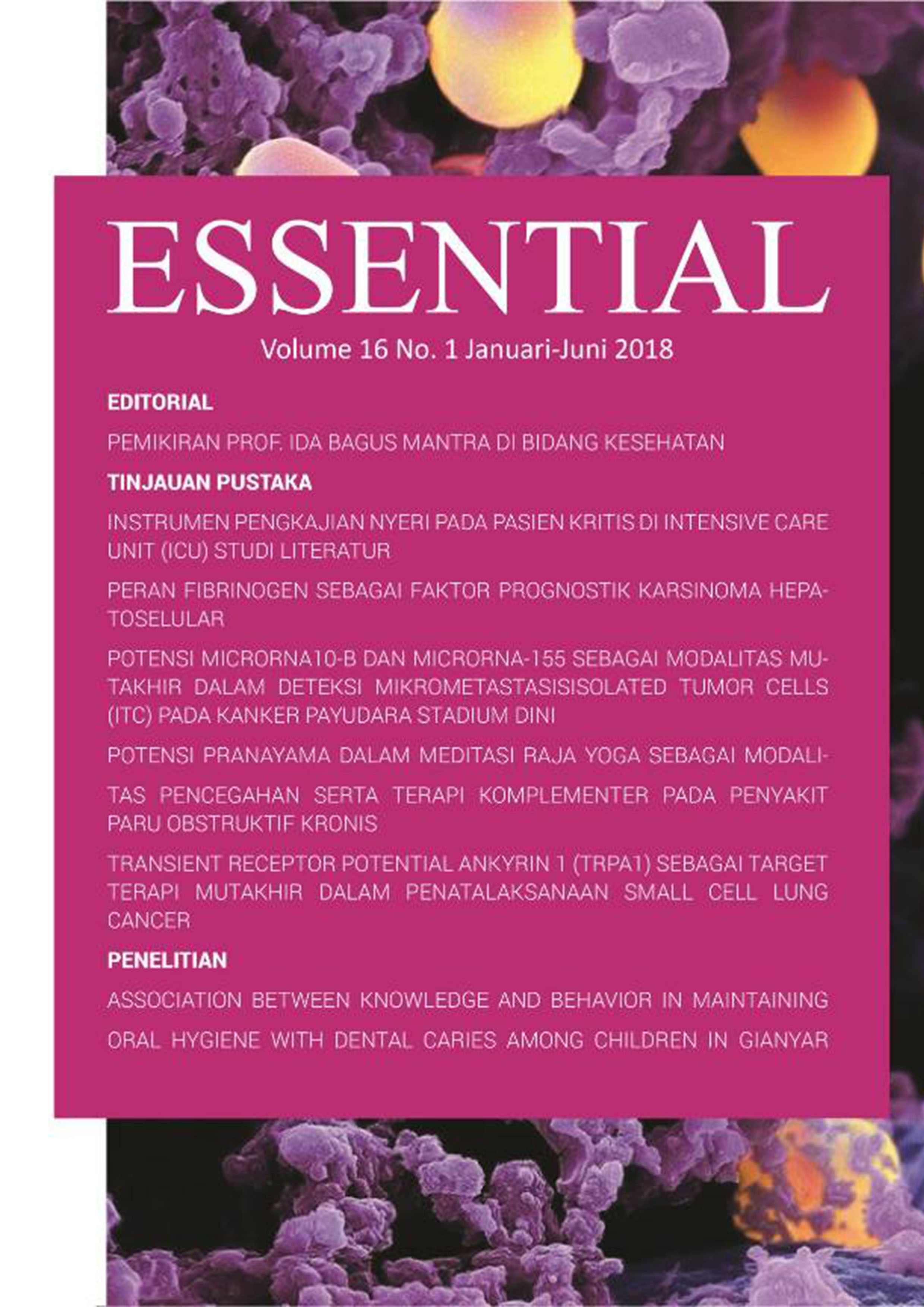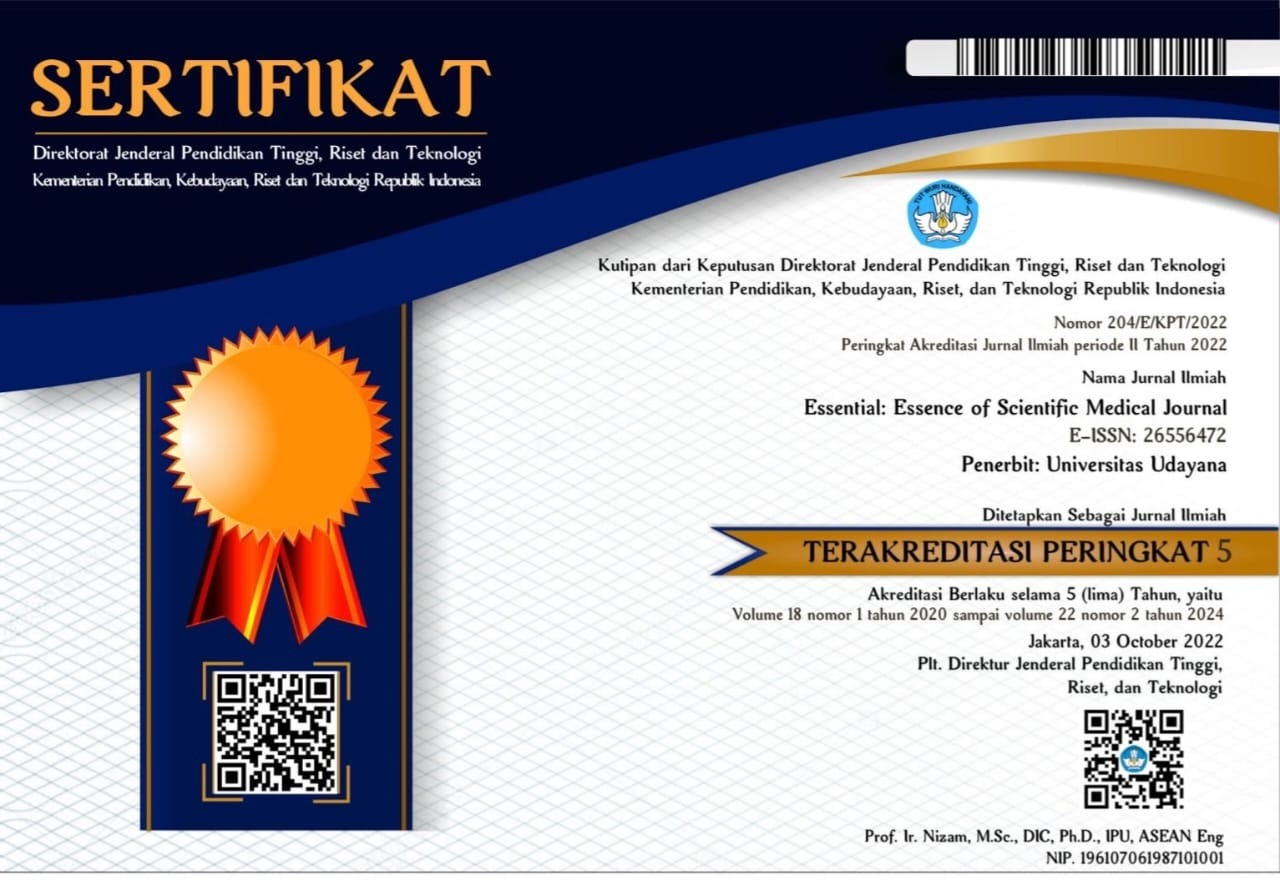TRANSIENT RECEPTOR POTENTIAL ANKYRIN 1 (TRPA1) SEBAGAI TARGET TERAPI MUTAKHIR DALAM PENATALAKSANAAN SMALL CELL LUNG CANCER
Abstract
Background: Lung cancer is a type of cancer with the highest incidence in Indonesia. In general, lung cancer can be divided into two groups based on its histopathology, which are Non-Small Cell Lung Cancer (NSCLC) and Small Cell Lung Cancer (SCLC). Small Cell Lung Cancer (SCLC) is originated from neuroendocrine precursor cell and has a very fast and uncontrollable cell growth characteristic. Cigarette consumption is closely related with SCLC because studies show that most of SCLC patients have a history of smoking. Consequently, an increase in the number of smokers in recent years is also accompanied by an increase in the incidence and mortality rates by SCLC.
Method: This review was made by using relevant journals from proquest.com, sciencedirect.com and scholar.google.com database with keywords Lung cancer, TRPA1, SCLC.
Results: TRPA1 functions as an ion canal that helps the entry of Ca2+ into the cells. In SCLC patients, TRPA1 is expressed highly in content compared to NSCLC and normal patients. TRPA1 holds an important role in many SCLC cell viability mechanisms. Continuous activation of TRPA1 will mediate the increase of Ca2+ influx into cancer cell thus causing an increase in SCLC progressivity. In other words, inhibition of TRPA1 will obstruct the process of Ca2+ influx into the cell which is followed by induction of apoptosis along with inhibition of metastasis, angiogenesis, also progressivity of SCLC.
Conclusion: TRPA1 is expressed in a significant numbers in SCLC cell, this ion canal can be used as a promising therapeutic intervention target in the future.
Downloads
References
2. Kementrian Kesehatan RI Pusat Data dan Informasi Kesehatan. Stop Kanker. infodatin-Kanker. 2015;hal 3.
3. Ruysscher D De, Popat S, Peters S, Felip E, Group GW. Small-cell lung cancer (SCLC) : ESMO Clinical Practice Guidelines for Diagnosis, Treatment and Follow-up. Ann Oncol. 2013;21:1–7.
4. Govindan R, Page N, Morgensztern D et al. Changing epidemiology of small-cell lung cancer in the United States over the last 30 years: analysis of the surveillance, epidemiologic, and end results database. J Clin Oncol 2006; 24: 4539–4544.
5. International Agency for Research In Cancer. Lung Cancer Estimated Incidence, Mortality and Prevalence Worldwide in 2012. 2012. [Internet] Tersedia pada: http://globocan.iarc.fr/Pages/fact_sheets_cancer.aspx? diakses [8 Juni 2017].
6. Abeloff MD. Abeloff's Clinical Oncology. 4th ed. Philadelphia: Churchill Livingstone Elsevier; 2008. Pp. 30-40
7. Berns K, et al. A functional genetic approach identifies the PI3K pathway as a major determinant of trastuzumab resistance in breast cancer. Cancer Cell.2007; 12:395–402.
8. Eichhorn PJ, et al. Phosphatidylinositol 3-kinase hyperactivation results in lapatinib resistance that is reversed by the mTOR/phosphatidylinositol 3- kinase inhibitor NVP-BEZ235. Cancer Res. 2008; 68:9221–30.
9. Nassini R, Pedretti P, Moretto N, Fusi C, Carnini C, Facchinetti F, et al. Transient Receptor Potential Ankyrin 1 Channel Localized to Non-Neuronal Airway Cells Promotes Non- Neurogenic Inflammation. 2012;7(8).
10. Bautista DM, Jordt S, Nikai T, Tsuruda PR, Read AJ, Poblete J, et al. TRPA1 Mediates the Inflammatory Actions of Environmental Irritants and Proalgesic Agents. 2006;1269–82.
11. Schaefer EAM, Stohr S, Meister M, Aigner A, Gudermann T, Buech TRH. Stimulation of the chemosensory TRPA1 cation channel by volatile toxic substances promotes cell survival of small cell lung cancer cells. Biochem Pharmacol [Internet]. Elsevier Inc.; 2013;85(3):426–38.
12. Murakamia, A. Kondoab, Y. Nakamuraa, H. Ohigashia & K. Koshimizua, Possible Anti-tumor Promoting Properties of Edible Plants from Thailand, and Identification of an Active Constituent, Cardamonin, of Boesenbergia pandurata, Biosci. Biotech. Biochem. 2008; 57:1971-3.
13. Venkatachalam K, Montell C.TRP Channels.Annu. Rev. Biochem, 2007;76:387–417.
14. Chen J, Hackos DH. TRPA1 as a drug target—promise and challenges. Naunyn-Schmiedeberg's Arch Pharmacol, 2015;388:451–463.
15. Nagata K, Duggan A, Kumar G, Garcia AJ. Nociceptor and hair cell transducer properties of TRPA1, a channel for pain and hearing.J Neurosci, 2005;25:4052-4061.
16. Mukhopadhyay I, Gomes P, Aranake S, Shetty M, Karnik P, Damle M, Kuruganti S, Thorat S, Khairatkar-Joshi N.Expression of functional TRPA1 receptor on human lung fibroblast and epithelial cells.J Recept Signal Transduct Res, 2011;31:350–358.
17. Tsutsumi M, Denda S, Ikeyama K, Goto M, Denda M. Exposure to low temperature induces elevation of intracellular calcium in cultured human keratinocytes.J Invest Dermatol, 2010;130:1945–1948.
18. Gratzke C, Weinhold P, Reich O, Seitz M, Schlenker B, Stief CG, Andersson KE, Hedlund P.Transient receptor potential A1 and cannabinoid receptor activity in human normal and hyperplastic prostate: relation to nerves and interstitial cells.Eur Urol, 2010;57:902– 910.
19. Shigetomi E, Tong X, Kwan KY, Corey DP, Khakh BS.TRPA1 channels regulate astrocyte resting calcium and inhibitory synapse efficacy through GAT-3.Nat Neurosci, 2012;15:70–80.
20. Cao DS, Zhong L, Hsieh TH, Abooj M, Bishnoi M, Hughes L, Premkumar LS. Expression of transient receptor potential ankyrin 1 (TRPA1) and its role in insulin release from rat pancreatic beta cells.PLos One, 2012;7:e38005.
21. Takahashi N, Mizuno Y, Kozai D, Yamamoto S, Kiyonaka S, Shibata T, Uchida K, Mori Y. Molecular characterization of TRPA1 channel activation by cysteine-reactive inflammatory
mediators.Channels, 2008;2:287–298.
22. Andersson DA, Gentry C, Bevan S. TRPA1 has a key role in the somatic pro-nociceptive actions of hydrogen sulfide.PLoS One, 2012;7: e46917.
23. Eberhardt M, Dux M, Namer B, Miljkovic J, Cordasic N, Will C, Kichko TI, et al. H2S and NO cooperatively regulate vascular tone by activating a neuroendocrine HNO-TRPA1-CGRP signalling pathway.Nat Commun, 2014;5:4381.
24. Linnoila RI. Functional facets of the pulmonary neuroendocrine system. 2006 ;( January):425–44.
25. Miki M, Ball DW, Linnoila RI. Lung Cancer Insights into the achaete-scute homolog-1 gene (hASH1) in normal and neoplastic human lung. Lung Cancer [Internet]. Elsevier Ireland Ltd; 2012;75(1):58–65.
26. Angelo SPD, Pietanza MC, Angelo SPD, Pietanza MC. cancer The molecular pathogenesis of small cell lung cancer. 2017;4047(August).
27. Bessac BF, Sivula M, Hehn CA Von, Escalera J, Cohn L, Jordt S. TRPA1 is a major oxidant sensor in murine airway sensory neurons. 2008;118(5).
28. Prevarskaya N, Ouadid-ahidouch H, Skryma R, Shuba Y. Remodelling of Ca 2 þ transport in cancer : how it contributes to cancer hallmarks ? 2014;1–10.
29. Roderick HL, Cook SJ. Ca 2 + signalling checkpoints in cancer : remodelling Ca 2 + for cancer cell proliferation and survival. 2008;8(may).
30. Qiagen. ERK Signalling. 2012. [Internet] Tersedia pada: http://www.sabiosciences.com/pathway.php?sn=ERK_Signaling. Diakses pada: 6 Juni 2017.
31. Mcilwain DR, Berger T, Mak TW. Caspase Functions in Cell Death and Disease.
32. Roelle S, Grosse R, Buech T, Chubanov V, Gudermann T. Essential role of Pyk2 and Src kinase activation in neuropeptide-induced proliferation of small cell lung cancer cells.Oncogene. 2008;27:1737-48.
33. Dasgupta P, Rastogi S, Pillai S, Ordonez-Ercan D, Morris M, Haura E, et al. Nicotine induces cell proliferation by beta-arrestin-mediated activation of Src and Rb-Raf-1 pathways.J Clin Invest. 2006;116:2208-17.


 SUBMISSION
SUBMISSION
















